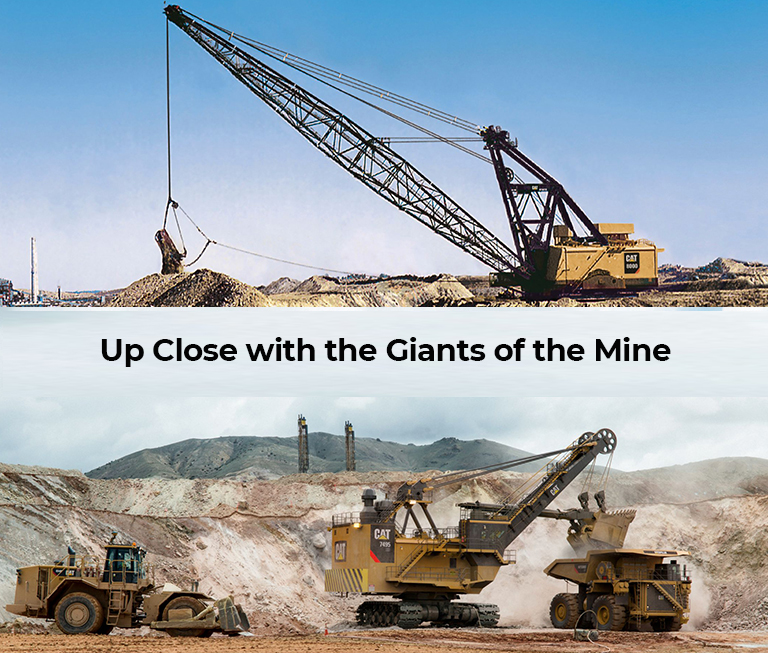Dragline vs. Rope Shovel: Understanding the Key Differences
Posted on: July 27, 2023
By : PRODUCTS & BRANDS

In the world of mining and excavation, heavy machinery plays a pivotal role in efficiently extracting valuable resources from the earth. Two of the most common types of equipment used for such purposes are draglines and rope shovels. While both serve similar purposes, their designs, functionalities, and applications differ significantly. This blog aims to shed light on the key differences between draglines and rope shovels, their advantages, limitations, and the scenarios in which each excels.
Dragline: The Gigantic Earthmover
A dragline is an enormous excavation machine used primarily in surface mining operations. Its name comes from the drag or dragline bucket that it employs to remove overburden, rocks, and other materials covering the coal, ore, or minerals to be extracted. Draglines are known for their colossal size, with some reaching heights of over 300 feet and weighing several thousand tons. They are usually supported by crawler tracks that enable them to move across mining sites.
Key Features of Draglines
Dragline Bucket
The dragline bucket is suspended from the boom by a hoist rope and drag rope system. The bucket's immense size allows it to scoop up large amounts of material in a single pass.
Boom
The boom is a long, rigid arm that supports the dragline bucket and provides the necessary reach to excavate the material.
Hoist Rope and Drag Rope
These ropes work together to control the movement of the dragline bucket. The hoist rope lifts and lowers the bucket, while the drag rope controls the bucket's angle and movement during excavation.
Walking Mechanism
Most draglines have a walking mechanism that enables them to move between mining areas. They can walk on their crawler tracks without the need for disassembly.
Advantages of Draglines
High Production Rate :
Draglines are known for their exceptional digging capacity, allowing them to move vast quantities of material in a short time, making them highly productive in large-scale mining operations.
Selective Mining :
The large dragline bucket and boom provide precise control, enabling selective mining and minimizing the removal of unwanted materials.
Efficient Overburden Removal :
Draglines excel in removing overburden from the mining area, reducing the cost of waste removal.
Limitations of Draglines
High Capital Cost :
The sheer size and complexity of draglines contribute to their significant capital cost, making them suitable for large mining companies with substantial resources.
Limited Mobility :
While draglines can walk to some extent, they are not as agile as other mining equipment, which can be a limitation in certain mining environments.
Rope Shovel: The Versatile Digger
A rope shovel, also known as a cable shovel, is another prominent piece of mining equipment used in surface mining operations. Unlike draglines, rope shovels have a more compact design and are typically mounted on tracks or tires, providing them with better maneuverability.
Key Features of Rope Shovels
Dipper
A rope shovel uses a dipper, also known as a bucket, for excavation. The dipper is connected to the machinery via a hoist rope and crowd rope system.
Boom
Like a dragline, a rope shovel is equipped with a boom that supports the dipper and controls its movement.
Hoist Rope and Crowd Rope
These ropes control the movement of the dipper. The hoist rope lifts and lowers the dipper, while the crowd rope controls the dipper's angle and enables it to dig horizontally.
Mobility
Rope shovels are equipped with tracks or tires, allowing them to move around the mining site with relative ease.
Advantages of Rope Shovels
Versatility
Rope shovels are highly versatile and can be used for various mining tasks, including digging, loading, and dumping materials
Lower Capital Cost
Compared to draglines, rope shovels generally have lower capital costs, making them a more accessible option for smaller mining companies
Better Mobility
Rope shovels' mobility allows them to operate in more confined spaces and varied terrains, making them suitable for mining sites with limited accessibility.
Limitations of Rope Shovels
Lower Production Capacity
Rope shovels have a smaller bucket capacity compared to draglines, resulting in a lower production rate in large-scale mining operations.
Reduced Selective Mining
The smaller dipper size of rope shovels limits their ability to perform selective mining efficiently.
Increased Overburden Removal
Rope shovels may require additional effort and time for overburden removal due to their smaller bucket size.
Conclusion
In conclusion, both draglines and rope shovels are vital pieces of equipment in surface mining operations. While draglines are colossal earthmovers known for their exceptional production capacity and selective mining capabilities, rope shovels offer increased versatility and better mobility at a lower capital cost. The choice between the two largely depends on the scale of the mining operation, the nature of the deposit, and the available budget.
Large-scale mining projects with substantial resources and significant overburden can benefit from the high productivity and selective mining capabilities of draglines. On the other hand, smaller mining operations with varied terrains and less overburden may find rope shovels to be a more practical and cost-effective choice.